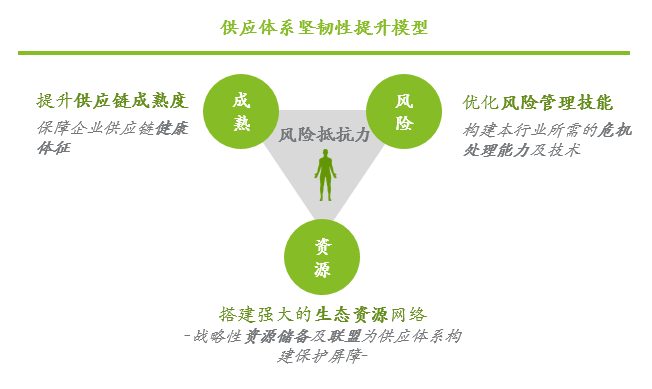Supply Chain Immunization Solutions During the Pandemic

Hi, everyone, I am Gong Geliang, a partner of Deloitte China Management Consulting, responsible for supply chain management consulting services. Today I would like to share with you the topic of “In the face of the pandemic, how we can fully support the enterprise supply chain management” Since the beginning of 2020, the spread of novel coronavirus has affected hundreds of millions of people from all walks of life across China. With timely and efficient deployment and guidance by the government, I believe that we will surely overcome the difficulties and obstacles.At the critical moment of fighting against the pandemic, many enterprises have been responding quickly to various supply chain emergencies, or considering and predicting what supply chain risks need to be prepared for in advance. Deloitte believes that in the face of supply chain risks, enterprises must consolidate the resilience of the supply chain, deploy comprehensive measures rationally and calmly, and systematically enhance the immunity of enterprises.

In the past, when risks occurred, many enterprises would adopt the event-driven method for management, and try to sum up all types of potential risk events in an exhaustive way. However, after years of research, many large enterprises found that this method is difficult to truly achieve the purpose of risk control, because the most vexed crises tend to be those that have never occurred or are difficult to predict. Therefore, Deloitte's recent researches have found that many prominent corporate managers have abandoned traditional methods and gradually explored more systematic approaches to risk prevention, which Deloitte summarizes as follows: 1. continuously improving the maturity of the supply chain; 2. strengthening risk management skills; 3 optimizing the layout of the ecological resource network. Enterprises will build excellent corporate risk immunity from these three dimensions.
Next, we will analyse such dimensions one by one.
Ⅰ,Improving the maturity of the supply chain: systematically checking and repairing the key "symptoms" in the healthy operation of enterprises’ supply chains
The occurrence of any kind of crisis is often the best time to test the quality of a company’s supply chain management. High-quality supply chain management does not only mean smooth sailing in calm weather, but perseverance in stormy weather. When a crisis comes, the hidden supply chain problems of enterprises will easily pop up, such as the lack of sorting and control of upstream resources, the lack of scientific support for inventory level setting, data distortion and fabrication, etc. Such supply chain management problems are often the biggest cause of the supply risk of enterprises during a crisis. Just like a person who adopts an unhealthy lifestyle such as drinking, smoking and staying up late, he or she will find himself or herself facing a higher risk of infection during the pandemic.
Therefore, no matter what industry they are in, enterprises should take this opportunity to conduct a comprehensive internal examination of their supply chain, and systematically improve the compliance and standardization of supply chain management, which is a crucial first step to prevent risks. The following aspects deserve special attention:
- Business scenario simulation analysis: according to the impact of the current pandemic on society and the industry, re-examine the market demands, conduct various business scenario simulations based on the potential development of the pandemic, and pay particular attention to the adjustment of demand, the adjustment of products and services structure, and the adjustment of delivery channels and modes;
- Adjustment of material requirements and production re-scheduling: according to the results of enterprise business scenario simulations, quickly adjust the original production schedule, re-disassemble and re-plan materials, and set a higher proportion of upper and lower buffer space;
- Adjustment of supplier collaborative plan: communicate and agree on the updated material plan with the primary and secondary suppliers, which will minimize the risk of high costs or supply shortages caused by the adjustment of the suppliers. Therefore, rapid collaboration and response with upstream partners is crucial in the current period;
- Overall inventory check: comprehensively check and sort various materials in stock or in transit in the upstream and downstream of the enterprise supply chain and finished goods inventory. In the past, some excellent enterprises maintained global supply for 1-2 months only by relying on in-transit inventory in the time of major supply shortage, and successfully overcame the difficulties;
- Asset structure adjustment: based on the business simulation of the enterprise, if there are potential medium and long-term negative impacts, it is necessary to comprehensively sort out various assets of the enterprise, quickly revitalize inefficient old assets, and ensure the healthy and sufficient cash flow or cash asset reserve of the enterprise;
- Network security and stability: enterprises currently rely on the internal system and network for a great deal of business data, operations and communication. Working from home or mobile working will place high requirements on the original system stability, network carrying capacity, and data security of the enterprise. The IT department needs to deploy sufficient resources in advance, strengthen and upgrade the enterprise's system and network, and quickly promote more efficient mobile office applications.
Ⅱ,Optimizing risk management skills: deploying the risk response capacity highly relevant to the industry attributes
In the face of the pandemic, different enterprises will face different types of crises due to their different business structures and scales and the different industries they are in: some enterprises are short of labor, some are short of upstream materials, and others may be in large fluctuations or decline in demand. Therefore, enterprises need to review and predict the problems that their own supply chain will face, and take corresponding preparatory measures for high-risk points. The following aspects deserve special attention:
- Backup plan for key risk points: enterprises should locate key risk points upstream and downstream of the supply chain, such as the shortage of certain types of special materials or the interruption of a circulation link. Detailed backup or alternative supply plans need to be developed for key risk points. Such plans often have no practices to follow and require a lot of brainstorming and creative input, and it will be late to make preparations when a risk point breaks out.
- Active intervention in upstream risk management: all links of the entire industry chain will have a huge impact on the head enterprises of the industry. Therefore, risk management is not only about internal operations, but all kinds of risks in upstream supply resources such as capital risks and material shortage risks, which need to be intervened in advance by assisting and guiding suppliers to conduct inventory check and preparation, and providing support and subsidies at high risk points;
- Downstream supply chain dredging and expansion: during this pandemic, logistics storage resources have become one of the core lifelines of the entire economy, supporting the rapid flow and deployment of various resources. Enterprises need to pay particular attention to the deployment and expansion of their downstream transport capacity, and develop plans for various scenarios in advance with third-party logistics partners to ensure smooth delivery;
- Emergency digital tool deployment: since the human resources of enterprises will still be in a relatively separated state in the short term, the efficiency of some key operations and management meetings in supply chain management will be affected to some extent. As for some special tests that rely on expertise, sales and operation plan coordination meetings, core equipment operation and maintenance, etc., enterprises should quickly deploy technical means, such as camera recognition, AR/VR technical solutions, and video conferencing systems, to solve some problems.
Ⅲ,Building a strong ecological resource network: quickly aggregating shared resources and funding networks
Nowadays, many enterprises regard ecological construction as a strategic market strategy. In the time of crisis, quickly finding an ally in the industry and building or joining an ecological resource network will greatly facilitate an enterprise in business and supply chains. This grouping practice has generated many successful cases during various crises that have occurred globally in recent years. Just like when a person is seriously ill, in addition to his or her own health foundation and treatment plans, he or she also needs sufficient money and connections to obtain quick and efficient treatment and recovery, so is the enterprise ecological construction. The following aspects deserve special attention:
- Activate the supply chain finance scheme: it is necessary to have a comprehensive understanding of the current supply chain finance schemes of various channels, conduct an overall examination from financial institutions, business competitors to government departments, and make detailed communication with relevant institutions to understand the relevant rules;
- Establish an ecological resource circle: abandon traditional thinking, comprehensively sort out the current resource status of competitors, partners, and clients in the industry and adjacent industries from the perspective of business competitors, identify potential shared and complementary resource categories, start the contact with top management, and quickly promote ecological program planning and implementation;
- ergers, acquisitions and reorganizations to fight against the “enemy”: some excellent enterprises with sufficient cash flow and solid business foundation can consider shares/assets buying to quickly obtain the guarantee of relevant resources, which will not only help them tide over the difficulties, but also improve the enterprise’s future competitiveness.
Finally, we hope that the enterprises and industries where our listeners come from will survive the pandemic, and that today's sharing will bring some insights into the future transformation of the supply chain of various enterprises. Let’s believe in ourselves and our country and get through the difficulties together.
If you have any questions, please feel free to contact us:
Gong Geliang
Partner
ggong@deloitte.com.cn
Disclaimer:
This communication contains general information only, and none of Deloitte Touche Tohmatsu Limited, its member firms, or their related entities (collectively the “Deloitte Network”) is by means of this communication, rendering professional advice or services. None of the Deloitte Network shall be responsible for any loss whatsoever sustained by any person who relies on this communication.
Copyright Notice:
© 2020 Deloitte Touche Tohmatsu in Hong Kong, Deloitte Touche Tohmatsu in Macau, Deloitte Touche Tohmatsu Certified Public Accountants LLP in the Chinese Mainland. All rights reserved.
